By C. Todd Lopez
WASHINGTON (Sept. 28, 2016) -- About 88 veterans of the Korean War arrived in the nation's capital this week for a visit to the Korean War Memorial Saturday, Sept. 24.
The veterans, who came to Washington, D.C., courtesy of Blue Ridge Honor Flight out of Ashville, North Carolina, laid a wreath at the memorial and also received from the Korean government a medal commemorating their service. Attending the event with the veterans was U.S. Forces Korea commander, Gen. Vincent K. Brooks, and Maj. Gen. Shin Kyoung-soo, a Korean defense attaché to the United States.
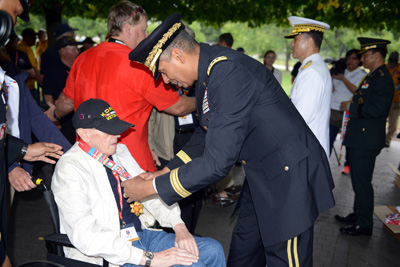
Shin told the veterans who gathered around him and Brooks near the memorial that he disagrees with the common characterization of the Korean War as "the forgotten war." Instead, he told them, he prefers "the forgotten victory."
Korea, he said, is now one of the world's top economies, one of the top trading partners of the United States, and one of the most innovative nations in the world. And like the U.S., Shin said, Korea can now also afford to send its own soldiers around the world to preserve the peace and maintain democracy. Korea, he said, is modern, well-off, and free.
"During the Korean War, and even after, Korea was a country who needed support from the United Nations," Shin told veterans. "Now Korea is a donor nation. Now Korea is enjoying freedom, democracy, and a market economy. How did this happen? How is this possible? It's because of your sacrifice, your dedication to protect my country and my people."
The general told the veterans that he and his countrymen remember what they did for Korea, because they now enjoy daily the prosperity that was made possible by American service members, 63 years ago.
"The Republic of Korea and the Korean Army will not forget your sacrifice and your dedication during the Korean War, and even after the Korean War," he said. "We will remember your sacrifice forever. We will pass down your legacy to our future generations."
The Korean War began June 25, 1950, and ended with an armistice on July 27, 1953. In all, on both sides of the conflict, more than 4.4 million military personnel and civilians were wounded, killed or went missing in action.
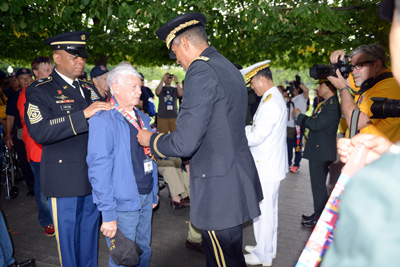
Today, the United States military maintains a presence on the Korean peninsula and remains committed to the defense of that nation, which is one of America's greatest allies in the Pacific.
"Our numbers are lower than they have been in history, but our commitment is no less," Brooks said.
Brooks, who is responsible for the more than 28,000 U.S. service members forward-stationed on the Korean peninsula, told veterans at the memorial that the troops he commands today are carrying on the legacy that established during the veterans' own service during the Korean War.
"I want to tell you how much I personally appreciate all that you did in your time," Brooks said. "You would be very pleased if you had the chance to come back to the Republic of Korea to see what that looks like. It is impressive. There is no question that what you did made a difference. And we who serve now are simply following in your footsteps to make sure that nothing ever puts that at risk."
Initially, Brooks had not planned to be at the memorial with the veterans. But he was, coincidentally, visiting the U.S. at the same time to meet with senior Army leaders at the Pentagon, and discuss the current situation on the Korean peninsula with defense and policy leaders.
"When I heard there was going to be an honor flight with 88 Korean War veterans on the day I was scheduled to fly back, I didn't want to miss it," he said. "I chose to come here, and I'll fly back to Korea as soon as I leave the ceremony."
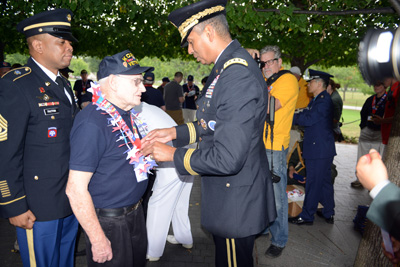
Even now, 63 years after the end of the Korean War, Brooks said, it remains important that we recognize the service of veterans.
"For those of us who served, we need to make sure we are acknowledging that we are part of a long line," Brooks said. "And these veterans are that line. So while we can recognize them, we should do so."
TIME IN HELL
Brownie McCall was among the 88 veterans who came to Washington, D.C., to visit the Korean War Memorial. He was drafted into the Army in 1951. "I was invited in by my president," he said.
He recalled his arrival in the country in 1951: "There was a sign up when we got there," he said. "A big sign hanging on an arch. It said 'don't worry about going to heaven, because you spent your time in hell.' That's what I think about it."
In Korea, he said, he initially served as a combat infantryman with the 1st Cavalry Division and carried an M1 Garand rifle. He was ultimately injured in combat and received a Purple Heart for his injuries.
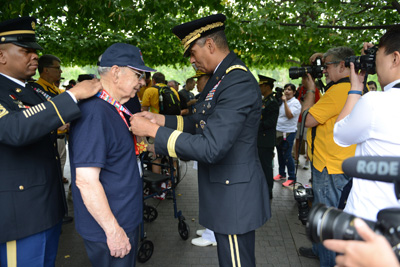
"It was about midnight," he said. "When the Chinese send all those troops against you, they are going to run over you. Some of them ran by me. I ran out of hand grenades, but they didn't. I was lying in a prone position, and I was firing the M1, and a hand grenade rolled up on me and I tried to throw it, and it went off."
He said he was knocked out for about six hours.
"I came to before daylight," he said. "I was bleeding fiercely, from my nose and ears and eyes. My rifle was blown apart too."
As a result of his injuries, he said, he was unable to continue to fight. He was later transferred to military intelligence and served with the 45th Infantry Division.
For McCall, it was his first trip to the Korean War Memorial.
"I'll never forget it," he said, gesturing to the 19 stainless steel statues within the memorial that represent a platoon on patrol. "The Soldiers there ... seeing them with their M1 Garands and walking through that foliage ... that brings back memories."
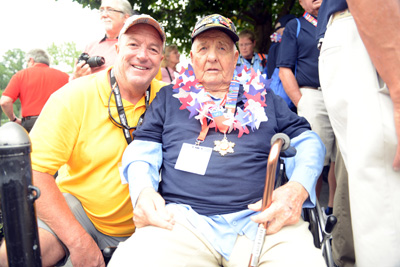
THEY SAY THANK YOU
Hilliard Staton, who joined the Navy in 1947, eventually got a commission in the U.S. Marine Corps in 1952. He found himself in Korea in 1953, where he was a tank platoon leader with 1st Marine Division, 1st Tank Battalion.
Staton was one of two veterans who laid a wreath at the memorial during the honor flight visit.
"Seeing this monument today brings back a great deal of memories," he said. "And they're not all pleasant. This is the most magnificent memorial I can imagine. It reminds me of the darkness of the night. I think about the cold, and I think about the variety of men who served with me during that period."
Staton said he arrived in Korea during the last year of conflict there.
"By the time I got there ... it was more like World War I," he said. "We were almost trench warfare along the line. We were in support of the Turkish brigade. Our primary job was to fire at night to prevent the Chinese from taking more land. We had the lines, they wanted the lines. Our job was to not let them take it, and their job was to try to get it back. That's mostly what we were doing."
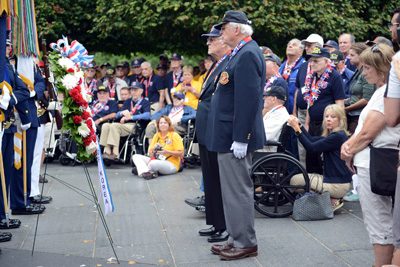
Not all Korean War veterans have been back to Korea since the end of the conflict there. But Staton has been. And he said he's impressed by what he saw there.
"It is a most fantastic country now," he said.
When he was there in 1953, he said, he never saw so much as a paved road or glass in the windows. He never even saw a town.
"But now, the town of Seoul could be Chicago, or Philadelphia. It is a most modern, beautiful city," he said. "And the Korean people are the most wonderful people you could imagine: very industrious, hardworking, and can accomplish anything they want to do."
A NATION'S BIRTH
James Jean, who enlisted in the regular Army in June 1950, laid a wreath at the memorial along with fellow veteran Staton. He served as a cryptographic specialist, arriving in Korea in May 1951.
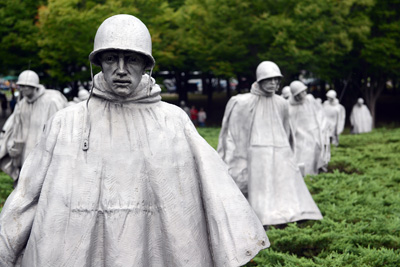
"I came in through Busan, and went by train up to the central front, and joined the 7th Infantry Division there," he said. "I remember the smell. It was a poor country. The houses they lived in. The powder on the road. The rice patties. We never saw paved roads. When we had a monsoon, the mud was so thick you couldn't drive a jeep, and the tank couldn't move. Nothing could move. It was eight or nine inches of mud."
Since then, he said, he has returned to Korea three times to visit. Much has changed since he first arrived there more than 60 years ago, he said.
"I stood on the 12th floor of the hotel and looked out on the boulevard," he said. "It's eight paved lanes of traffic. Two middle lanes were busses. There were 12 different bus routes. There were nine subways. You could get on a train in Seoul, and be in Busan in 2 hours and 10 minutes. You can't do that here."
On one trip he made to Korea, he said, he visited Panmunjom, at the Joint Security Area on the demilitarized zone between South Korea and North Korea. There, he was paired up with a Korean school girl as part of the educational tour set up for him and fellow veterans by the Korean government.
He said he continues to correspond with her. She calls him "halabeoji," which means "grandfather." He calls her "sonnyeo," which means "granddaughter."
"She sent me an email, and she said, 'You were at the birth of my country,'" he said. "And that really, really set in. We were at the birth of their country. And when you look at what it was when I was there, to what it is now? Yeah, she was right."